Veterinary profession's value to Scotland: preliminary economic assessment
A preliminary economic assessment of the veterinary profession’s value to Scotland.
3. Veterinary Impacts
A report published by RCVS and BVA in 2015 (VetFutures, 2015) highlights the influence, prominence and impacts of the veterinary profession across a wide range of areas including "protecting animal health and welfare, the natural environment, biodiversity, managing invasive species, climate change, food security, research and development, and antimicrobial resistance". The report emphasises on the roles of veterinarians in society as well as their crucial contribution to the government's decision-making process in all matters relating to animal science, public health and environmental sustainability. Other impacts of the veterinary profession identify by the mentioned report are: working with medical professionals to address public health agenda, roles in communicates by supporting farming clients, contributing to food-security as a result of working in partnership with farmers, tackling a wide range of scientific challenges, playing crucial roles as experts on national and international platforms and playing a central role in delivering a vision for veterinary research.
Figure 8 Areas of vets' contribution to the society (Vet Future Report 2015)
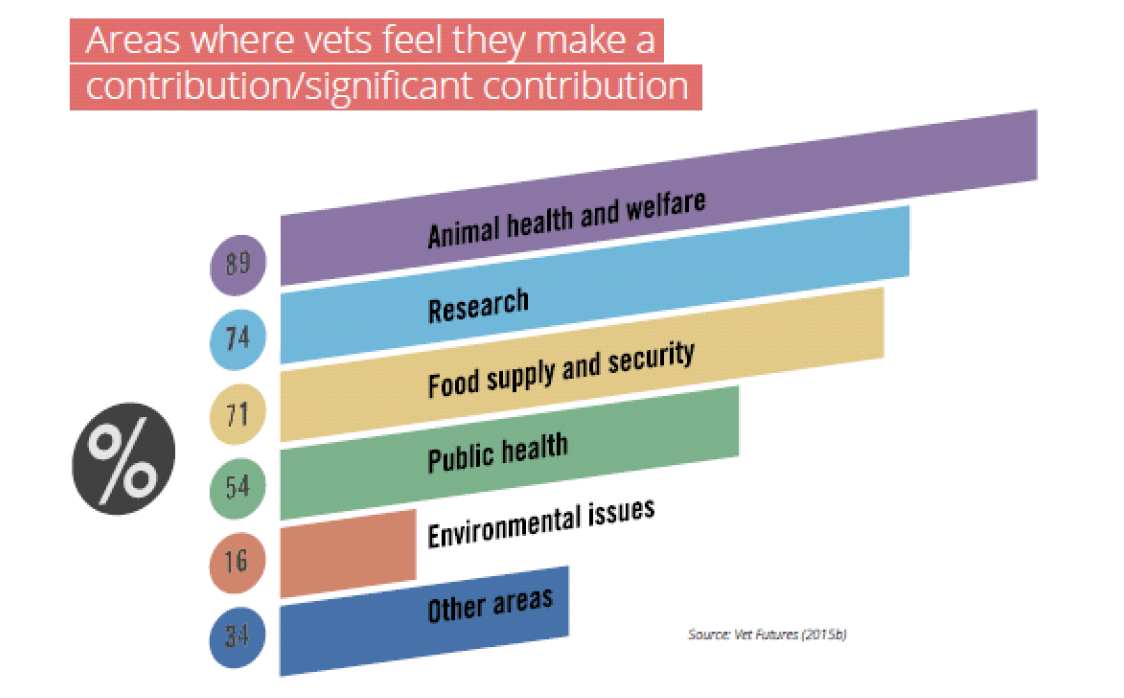
On tackling grand challenges, such as increasing demand for meat protein, the Vet Futures Report (2015) states that: "veterinarians are expected to play a greater role through improving animal health and in helping society understand the broader challenges of sustainable animal agriculture. This includes the need for environmental protection, good animal welfare and public health education on healthy levels of dietary meat intake".
Figure 9 Indicative impacts from poor animal health
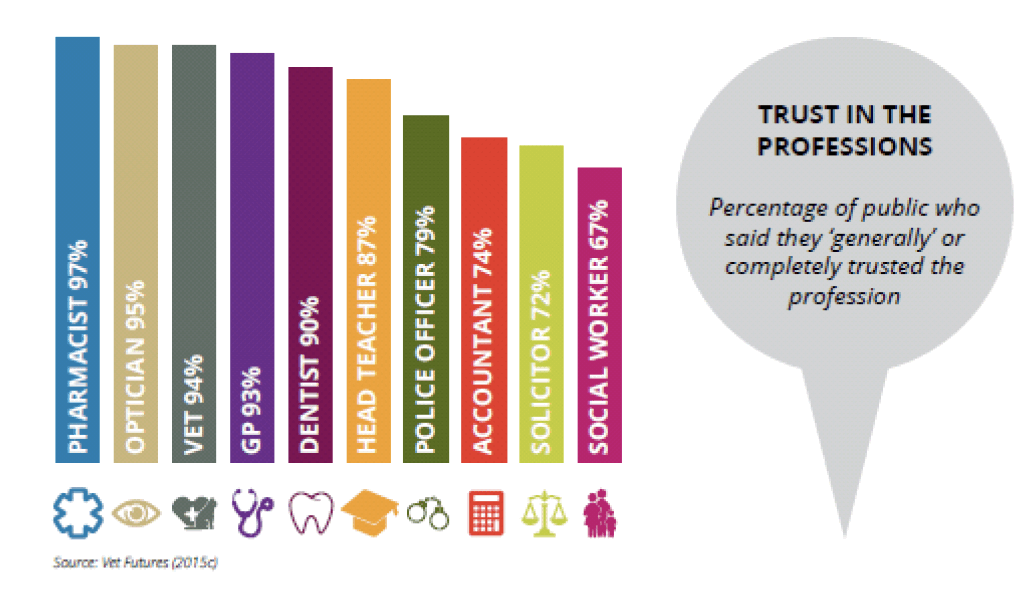
In addition the roles of veterinarians in contributing to the "One Health" concept covering areas such as bioterrorism, antimicrobial resistance, climate change, transboundary disease, ecosystem health and sustainability, and zoonotic disease control are highlighted by the report. The report also refers to a survey conducted by BVA that reflects the views of their members on the importance for vets of having a respected and valued role in society, and a perception that the public attaches little value to areas such as food production, safety and security, and public health. According to the report, "many comments from vets reflected a desire to increase awareness of the breadth of contributions vets make beyond companion animal health, and raising the profile of veterinary contributions to public health was identified as a key aim for the future".
3.1 Impacts on agriculture
Rushton (2015) summarised animal health impacts, discussing the visible losses caused by disease (such as death, meat quality, etc.) along with invisible losses (such as fertility, public health, etc.) that may lead to lost revenues and additional costs of medicines, time to treat animals, etc. (see Figure 10).
Figure 10 SAC Customer Satisfaction Survey – Sources of Advice and Usefulness to Business
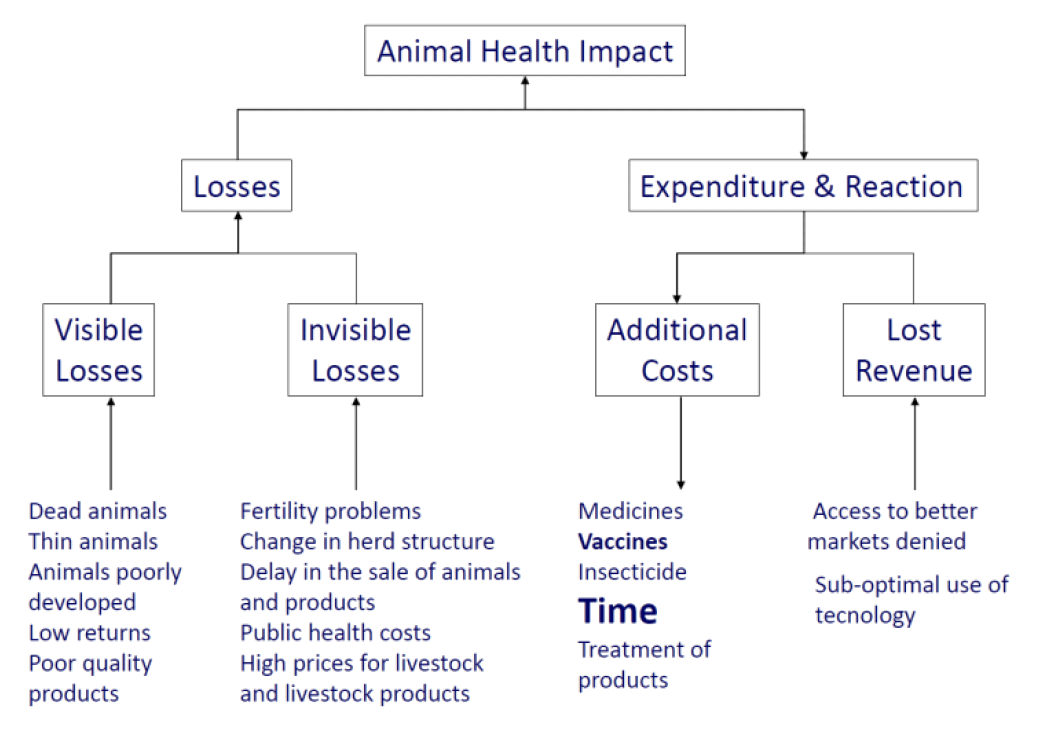
At a very basic level, veterinarians are valued as they can safeguard resources (farmed animals, pets, or wildlife) and enable farmers to maximise output from the other resources they utilise in animal production (feed, labour, buildings, land, machinery, etc.). The farm vet, in essence is a specialist resource that farmers spend money on to maximise returns, but also to help ensure animal welfare, whilst acting as a social contact for many lone-working farmers in modern Scottish agriculture. In relation to contribution of veterinarians to the health and welfare of animals, there are some literature that indicates there is a disparity between what some of these clients want and what veterinarians are providing. Hall et al. (2012) found that, whilst farmers and vets agree on the three primary functions of the vet on a farm, farmers were unaware of some of the services vets could offer. Also, while vets wanted to position themselves as 'friend' to the farmer, farmers tended to place value in having a proactive vet who could provide sound technical advice.
The veterinary profession in Scotland directly support the £1.77bn output generated annually from livestock and safeguard the £1bn of breeding livestock and £1bn of trading livestock in the country – from estimated £64m agricultural expenditure on veterinary services a year across Scotland.[6]Thus for every £1 spent on veterinary services in Scotland farmers generate £26.52 in output or it can be seen to be safeguarding the health of £15 of breeding stock and £156 of trading stock.
For every £1 spent on veterinary services in Scotland farmers generate £26.52 in output or it can be seen to be safeguarding the health of £15 of breeding stock and £156 of trading stock.
Research (Cresswell et al, 2014; Richens et al, 2015) demonstrate the important role that veterinary practices play in farmer decision making, particularly around advice on vaccinations, with 93% purchasing vaccines through their veterinary practices. In 2016 SAC Consulting undertook a customer satisfaction survey of 700 agricultural clients (unpublished) and the results corroborate the importance of vets as a source of advice and support to the Scottish farming industry. Figure 10 shows that in 2016 SAC Consulting farm and crofter clients (note that the use figure includes non-livestock farms) ranked the advice and support provided by vets above all other sources, revealing the close and trusted relationship that farmers and crofters have with their vet as a specialist resource to draw on.
In 2017 Biggar Economics in assessing the Economic Contribution of Scotland's Rural College (unpublished) estimated that SRUC's Premium Cattle Health Scheme[7] and Premium Sheep and Goat Health Scheme added £13.7m GVA to the UK livestock sector in 2016, of which around £2.7m GVA was retained in Scotland.
Figure 11. SAC Customer Satisfaction Survey – Sources of Advice and Usefulness to Business.
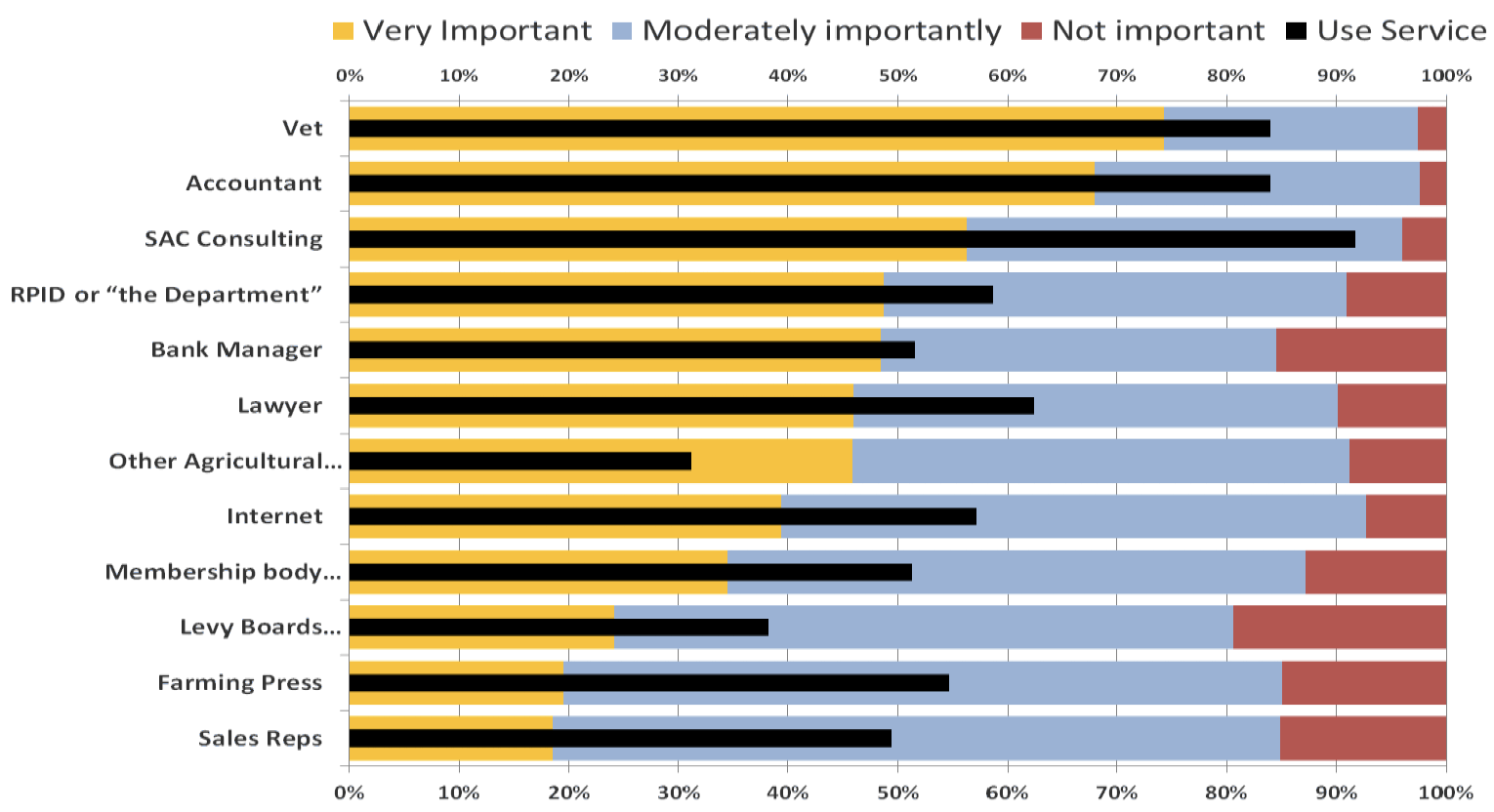
3.1 Impacts through animal disease control
The impacts of veterinary profession on farm animals in relation to improve health and productivity are categorised under three groups: i) prevention, control and treatment of diseases and animal welfare conditions; ii) health care activities costs; and iii) contribution to feed and pharmaceutical industries.
Whilst the potential avoided costs from disease outbreaks, and the size of the sectors were estimated it must be noted that it is difficult to assess the attribution of value to vets. Furthermore, as the avoided costs are highly probabilistic they should not be summed to provide estimated of accumulated impacts. They do however provide indicative figures for the significant role to be played in monitoring, preventing and controlling animal disease in Scotland and the scales of potential costs of outbreaks.
3.1.1 Prevention, control and treatment of disease
Veterinarians play a key role in combating farm animal diseases. Their activities are focused on prevention, control and treatment of diseases animals in both breeding and trading livestock. This means that vet services impact on annual farm output as well as on the underlying balance sheet value of Scottish farmed animals. Among many items, the impact of the veterinary profession in combating livestock diseases depends on the type of diseases. Infections endemic and exotic livestock diseases impose substantial financial and social costs to farmers and rural communities. In this study diseases and welfare conditions of farm animals are categorised under three main categories of infectious, non-infectious and animal welfare problems.
3.1.1.1 Infectious diseases
Infectious diseases of livestock are categorised under three categories namely: endemic, exotic and zoonotic diseases. Existing information and published studied have been used to estimate the impacts and contribution of the veterinary profession to reduce the costs of the three categories of infectious diseases in Scotland.
Endemic diseases
The direct costs of 30 endemic diseases of livestock in Great Britain were previously estimated and reported indicating low, middle and high estimation for each disease (Bennett, 2003; Bennett and Ijpelaar, 2005). To have provide an estimate of the contribution of the veterinary profession in controlling endemic diseases, it was assumed under two scenarios that the veterinary profession was responsible for moving the farming industry from pervasive ('high') disease prevalence to either 'medium' or 'low' disease prevalence ('high to middle' and high to low' scenarios). From Bennett and Ijpelaar's data (adjusted based price index for 2016 [8]) the cost difference associated with 'high' prevalence and 'medium' or 'low' disease prevalence in Scotland was then used to estimate an economic value for endemic disease control that is attributable to the veterinary profession. The proportion of GB livestock population in Scotland used for cattle, sheep, pig and poultry were: 18%, 20%, 6%, and 9% respectively. Figure 11 illustrates the estimated total farm level costs that may be saved as a result of the Scottish veterinary profession controlling endemic disease prevalence in 2016.
It should be noted that respiratory disease (pneumonia) of cattle was not as it was not covered in the reference studies used (Bennett, 2003; Bennett and Ijpelaar, 2005). However, pneumonia of calves in beef and dairy farms is known as a major cause of financial and productivity losses. It was estimated that pneumonia costs £43-84 per cow per year (Potter, 2007). Bazeley (2011) estimated the costs in a 350-cow dairy herd at £17,000 or £48 per cow (£54 per cow adjusted for figures in 2016). The costs were due to: 9% mortality rate in calves (benchmark is around 5%); reduced growth rates at 0.44 kg/day (benchmark target is 0.8 kg/day); and veterinary drug costs that were £3,180 for the herd, or £9 per cow.
Figure 12. Annual avoided costs (£m) from endemic diseases control by the Scottish veterinary profession under scenarios of reducing prevalence from ‘high to medium’ and from ‘high to low’ , 2016.
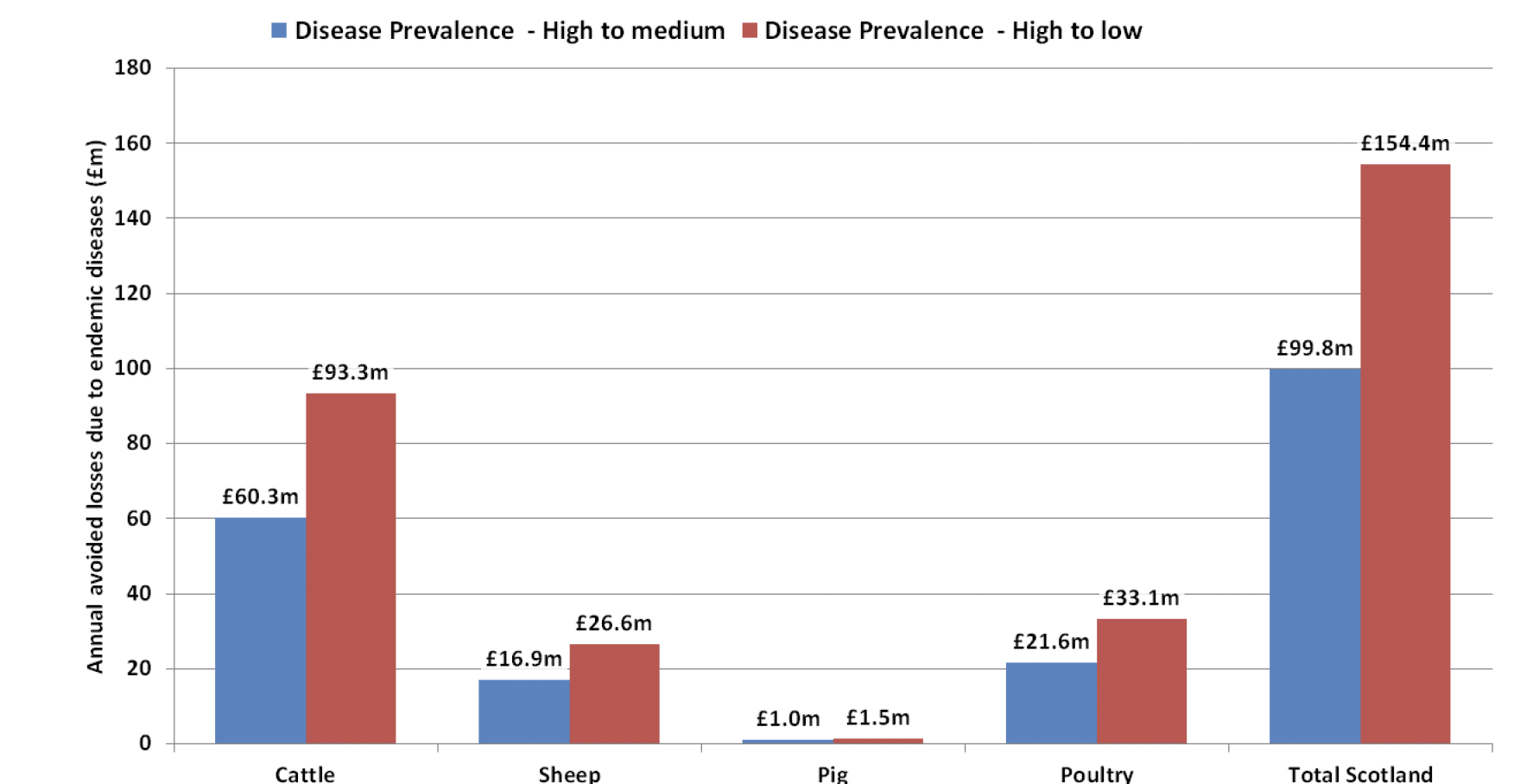
Table 7 presents details of the avoided costs attributed to Scottish vets from reducing individual disease prevalence to 'medium' or 'low' levels. Based on these estimations, the total annual avoided costs of endemic diseases due to veterinary services are estimated at average of £127m with a minimum of £100mand amaximum of£154m.
Table 7. Annualised estimated avoided cost of endemic diseases of farm animals in Scotland - based on original model of Bennett (2003); adapted and adjusted for the Scottish livestock population and for two scenarios of reducing disease prevalence from high to medium and from high to low.
| Cattle | ||
|---|---|---|
| Avoided cost (£m) | ||
| Disease | high to med | high to low |
| BVD-MD Complex | 5.90 | 9.80 |
| E. Coli | 1.85 | 2.87 |
| Enteric disease | 0.44 | 1.02 |
| Fascioliasis | 4.79 | 7.68 |
| IBK | 1.88 | 3.32 |
| IBR | 0.26 | 0.50 |
| Lameness | 14.65 | 20.76 |
| Leptospirosis | 3.76 | 5.34 |
| Mastitis | 17.85 | 29.58 |
| Parasitic bronchitis | 2.00 | 3.33 |
| Paratuberculosis | 2.54 | 2.66 |
| Pasteurellosis | 0.15 | 0.20 |
| Salmonellosis | 2.82 | 4.02 |
| Summer mastitis | 1.45 | 2.20 |
| Total | 60.33 | 93.28 |
| Sheep | ||
|---|---|---|
| Avoided cost (£m) | ||
| Disease | high to med | high to low |
| Blow fly strike | 0.12 | 0.21 |
| Enzootic abortion | 7.29 | 11.03 |
| Maedi-Visna | 0.63 | 1.05 |
| Orf | 5.47 | 7.53 |
| Scrapie | 0.09 | 0.18 |
| Pulmonary Adenomatosis | 0.15 | 0.24 |
| Toxoplasmosis | 2.21 | 4.00 |
| Total | 16.94 | 26.57 |
| Pig | ||
|---|---|---|
| Avoided cost (£m) | ||
| Disease | high to med | high to low |
| Atrophic rhinitis | 0.18 | 0.32 |
| Enteric disease | 0.19 | 0.30 |
| Streptococcus suis type II meningitis | 0.12 | 0.12 |
| Swine dysentery | 0.12 | 0.18 |
| Swine influenza | 0.36 | 0.55 |
| Total | 0.96 | 1.46 |
| Poultry | ||
|---|---|---|
| Avoided cost (£m) | ||
| Disease | high to med | high to low |
| Coccidiosis | 0.22 | 0.54 |
| Infectious Bronchitis | 5.44 | 7.77 |
| Infectious Bursal Diseases | 0.27 | 0.37 |
| Marek's Disease | 0.04 | 0.08 |
| Salmonellosis | 15.25 | 23.58 |
| Skeletal Problems | 0.38 | 0.80 |
| Total | 21.60 | 33.14 |
Exotic diseases
The avoided costs due to exotic diseases were estimated for three diseases namely: foot and mouth disease (FMD), bluetongue (BTV) and avian influenza (AI) based on the observed prevalence and costs of previous outbreaks and assumed anticipated outbreak frequency. The total avoided costs due to the three mentioned exotic diseases are estimated at £135m. The assumptions and avoided costs estimations are described below.
- FMD
Details of direct and indirect costs of FMD 2001 outbreak in the UK have previously been reported (Thompson et al., 2002). It was estimated that the economic effect of FMD outbreak on the agricultural industries of Scotland was £85m with compensation costs of £419m, tourism losses of £437m and indirect losses of £311m. In this study a proportion of the UK overall costs arising from the 2001 outbreak were allocated for Scotland (based on livestock proportions). These costs were then adjusted for inflation using 2001 and 2016 price index. It was then assumed that the frequency of FMD outbreaks follows a triangular distribution with an annual probability of an outbreak of 2% (i.e. a one in 50 year event); most likely 5% (one in 20 year event); max 10% (one in 10 years). Therefore the total annualised cost avoidance resulting from veterinary intervention was estimated by adjusted the estimated costs by the simulated probability. On that basis it is estimated that by preventing a major outbreak of FMD (similar to 2001) the estimated avoided costs to the Scottish economy are about £107m.
Table 8. Details of the estimated costs of an outbreak of FMD for the Scottish economy (Thompson et al (2002) adjusted for the proportion of costs in Scotland and for inflation).
| Cost Item | Estimated annual avoided costs due to FMD (£m) | ||
|---|---|---|---|
| UK 2001 | Scotland 2001 | Scotland 2016 | |
| Direct agricultural loss | 525 | 85 | 128 |
| Compensation by government | 2,585 | 419 | 631 |
| Tourism | 2,700 | 437 | 659 |
| Indirect agricultural loss | 85 | 14 | 21 |
| Indirect tourism loss | 1,835 | 297 | 448 |
| Total | 7,730 | 1,252 | 1,885 |
| Annual estimated avoided cost of outbreak (1 in 18 years outbreak) | 107 | ||
- BTV
The total avoided costs of a bluetongue outbreak in Scotland in a five year period was previously estimated at £344m in 2008 (Fofana et al., 2016). This equates to an annual cost of £84m in 2016 (adjusted for inflation) if there had been an outbreak. Assuming an annual outbreak probability follows a triangular distribution with the values of minimum 5% (i.e. a one in 20 year event); most likely 10% (one in 10 year event); maximum 20% (one in five years), the total annual avoided costs due to BTV is estimated at £9.88m.
- AI
The majority of the cases of Avian Influenza in captive birds in Scotland have been Low Pathogenicity of the disease. However outbreaks of highly pathogenic avian influenza (HPAI) could be expected. The benefit of the Scottish economy of preventing outbreaks of HPAI was estimated based on the direct costs observed and reported from the Netherlands for the outbreak of 2003 (Meuwissen, 2006). The cost of outbreak of 2003 was estimated at €250m or £220m[9]. This was then adjusted for inflation to get £319m for 2016 prices. The Scottish poultry sector in 2013 was approximately 9% of the UK flock and using the EU Parliament data (European Parliament, 2010) the Netherlands poultry sector was estimated to be three-quarters the size of the UK. Given Scotland accounts for 9% of the UK flock that means attribution of avoided costs should be in the region of 12% of the Netherlands costs (cost of outbreak of £38m in 2016). Assuming an annual outbreak probability follows a triangular distribution with values of 2% (i.e. a one in 50 year event); most likely 5% (one in 20 year event); max 10% (one in 10 years), the annual avoided costs of a disease outbreak is estimated to be £2.2m assuming that the size of the outbreak and the damage are identical to the reference outbreak in the Netherlands.
Zoonotic diseases
Annual avoided costs caused by four zoonotic diseases namely BSE, salmonella, campylobacter and E.coli O157 was calculated. The total estimated annual avoided costs for the four mentioned diseases were £96m. The details of calculations are presented below.
- BSE
The national BSE enquiry reported that the total cost of BSE outbreaks in the Great Britain was estimated at £3.7bn in 2001 or £5.6bn in 2016 adjusted for inflation (Phillips et al., 2000). Assuming these costs are proportionate to the population of cattle in the country, this figure is translated to £1bn in Scotland (18% of the GB cattle herd in Scotland). Assuming an annual outbreak probability follows a triangular distribution with values of minimum 2%, most likely 5% and maximum 10%, the annual avoided costs of a BSE outbreak is estimated at £58m.
- Salmonella
The costs of salmonella for the Scottish economy in 1985 was estimated at £5.5m (Yule et al., 1988) that equals to £15.4m in 2016 adjusted for inflation. Assuming an outbreak of the disease follows a triangular distribution with the values of minimum 10%, most likely 20% and maximum of 100%, the annual avoided costs is estimated at £6.6m.
- Campylobacter
It was previously estimated that campylobacter infection cost the UK economy over £113m in 2000 (ACMSF, 2005). This equals to £172m in 2016 adjusted for inflation. The number of human cases in Scotland was reported at 6,246 (NHS, 2016). The proportion of human cases in Scotland to the cases in the UK was estimated at 11%. Using this information, the annual avoided costs due to campylobacter in Scotland is estimated to be £19m.
- E.coli O157
The burden of human infections with E.coli O157 was previously estimated at £11m in 2011 (Low et al., 2011). This equates to £12.3m in terms of annual avoided costs of a Scottish E.coli outbreak in 2016.
3.1.1.2 Non-infectious diseases and welfare
The total costs to the agricultural industry due to non-infectious diseases and welfare issues were also considered in this study (please note that this is not an exhaustive list). Whilst not expressing an aggregated veterinary impact figure they provide indicative figures for the potential impact from veterinary intervention for a number of animal diseases / conditions. It is acknowledged that disease control and treatment is not wholly attributable to the veterinary profession, rather a partnership between research, farmers, vets, veterinary medicine suppliers, etc. Disaggregating the impact of vets is extremely difficult and outwith the remit off this study.
Metabolic diseases
Veterinarians play a pivotal role in preventing and treatment of metabolic disorders. Hypocalcaemia, retained placenta, ketosis and left displaced abomasum are few examples of metabolic conditions in dairy cattle. The costs of each of these conditions are estimated at: £138, £157, £115 and £237 per case respectively (adjusted for inflation and exchange rate based on reported figures by Guard, C. 1998 reported by Warren, 2016). Assuming 1.5% of the Scottish dairy herd are annually affected by these conditions (i.e. 2,636 cases per year) the total industry costs (lost revenue). Vets work closely with farmers to minimise instances of these metabolic diseases.
Reproduction conditions
Stott et al., (2008) reported that improving reproduction performance of the suckler cow herd in Scotland could improve the profitability of these animals by £64 per cow in 2003, or £93 in 2016. Assuming 41% of breeding herds are affected by infertility problems (Stott et al., 2008) and a within herd infertility rate of 5%, the estimated potential benefit associated with veterinary intervention on suckler cow reproduction is £1m. Langford and Stott, (2012) estimated that Improving reproduction performance in dairy cattle could improve profitability by £33 per cow in 2011, £37 per cow in 2016 prices. Assuming an infertility rate of 20% in dairy herds, estimated potential benefit associated with veterinary intervention on dairy cow reproduction is £1.3m.
3.1.1.3 Animal welfare
The role of veterinarians in improving the level of animal welfare in farm animals is crucial. Lameness and mastitis that are considered as two main animal welfare problems in dairy cow were included under the endemic diseases in the current study. Amongst the many animal welfare conditions across farm animal species, the study examined three main diseases of sheep that have substantial animal welfare implications. The economic cost of gastrointestinal parasites infestation, footrot and sheep scab in the Scottish sheep herd were reported at £84m, £24m and £8m respectively in 2005 (Nieuwhof, and Bishop, 2005). Adjusted for price inflation these are equal to £115m, £33m and £11m respectively. Assuming a 10% improvement could be achieved as a result of veterinary interventions and advice, the expected annual benefit from future veterinary interventions could exceed £16m.
3.1.2 Summary of impacts on farm animal sector
There is a wide range of animal disease, prevention control and treatment, pharmaceutical sales and advice and feed industry monitoring and rationing advice that Scottish veterinarians provide. Whilst this section has aimed to highlight the avoided costs from stopping disease outbreaks, and the size of the sector it is (a) difficult to assess the contribution of vets and (b) as the avoided costs are highly probabilistic they should not be added to provided accumulated impacts. They do however provide indicative figures for the significant role to be played in monitoring, preventing and controlling animal disease in Scotland and the scales of potential costs of outbreaks.
The role of veterinarians in the UK and in Scotland may become more important with the UK Government's possible drive toward supporting public goods post Brexit that will include animal health and welfare. For example veterinary surgeons negotiate, draft and uphold necessary legislation and international standards. By carrying out surveillance and enforcement from farm-to-fork, official veterinarians certify the trade in animals and animal products thus contributing to economic prosperity and the sustainability of food production. The future of the UK agri-food production post Brexit is therefore of great interest and importance to the veterinary profession (BVA, 2017).
3.2 Impacts through companion animals
The contribution of veterinary profession to the economy of Scotland through domestic pets can be viewed under three main categories namely: i) health and well-being of pet animals, ii) impact on health and well-being of pet owners, and iii) direct and indirect contributions to the related industries such as pet food, pharmaceuticals, accessories and insurance. In relation to contribution of veterinarians to the well-being of pet animals and their owners, there are some literature that indicates there is a disparity between what some of these clients want and what veterinarians are providing. Similar to observation of Hall et al. (2012) who found that, farmers were unaware of some of the services vets could offer, significant differences have been identified between the attributes of 'a good vet' most valued by pet owners and those considered important by vets themselves (Mellanby et al., 2011).
3.2.1 Wellbeing of owners
LaFayette and Buser (2017) highlight that "animals convey a wide variety of physical, behavioural, mental, psychological and social benefits….among these are the therapeutic value of owning and caring for pets." Hodgson and Darling (2011) dubbed the human health benefits derived from animal interactions as 'zooeyia', contributing to the 'One Health' concept. These benefits reportedly include lower blood pressure, alleviation of depression, and improvements in patients suffering from severe mental and emotional conditions, including schizophrenia, psychosis, autism, and post-traumatic stress syndrome (LaFayette and Buser, 2017). Hall et al. (2016) estimated that direct and indirect costs and benefits of companion animals to the UK economy in relation to health and well-being on human owners. They calculated that the total benefit or avoidable costs to the National Health Service (NHS) through reduced number of doctor visits and other health benefits was around £2.5bn per year in 2013 for the UK. Adjusting this for the proportion of human population in Scotland (8%) to the UK population, the total health benefit of pets for the economy in Scotland is estimated at £209m. Undoubtedly health services provided by pet animals' veterinary profession play a key role in delivering this positive contribution. It is likely that the health of animals contributes to this health care benefit meaning that some of this benefit is likely attributable to the veterinary profession.
3.2.2 Pet insurance and accessories
It is estimated by the Association of British Insurers (ABI) (ABI, 2017) that the UK pet population stands at around 57 million, with an estimated 40% of households owning a pet. Despite the vast majority of pet owners not insuring their pets, the ABI report that the UK pet insurance industry paid out a record £706m in claims in 2016 (estimated at £57m in Scotland). Over 900,000 claims were made in the UK, with 708,000 claims for dogs alone - paying out £544m (estimated at £44m in Scotland), and 193,000 claims for cats, worth £112 million (estimated at £0.9m in Scotland). The ABI suggest theta the 3.5% increase in Insurance Premium Tax in 2016 would cost pet owners some £31m suggests that pet insurance premiums totalled over £885m in 2016 (ABI, 2016) (estimated at £71m in Scotland). Mintel report that the UK market is expected to grow from £976m in 2015 to £1.6bn by 2021 (FT, 2017). It should be acknowledged that the insurance also covers non-veterinary expenses such as third party liability, replacement cost, advertising costs, pet care in case of hospitalisation holiday cancellation, etc. Thus, the full cost of insurance claims cannot be attributed to the veterinary profession.
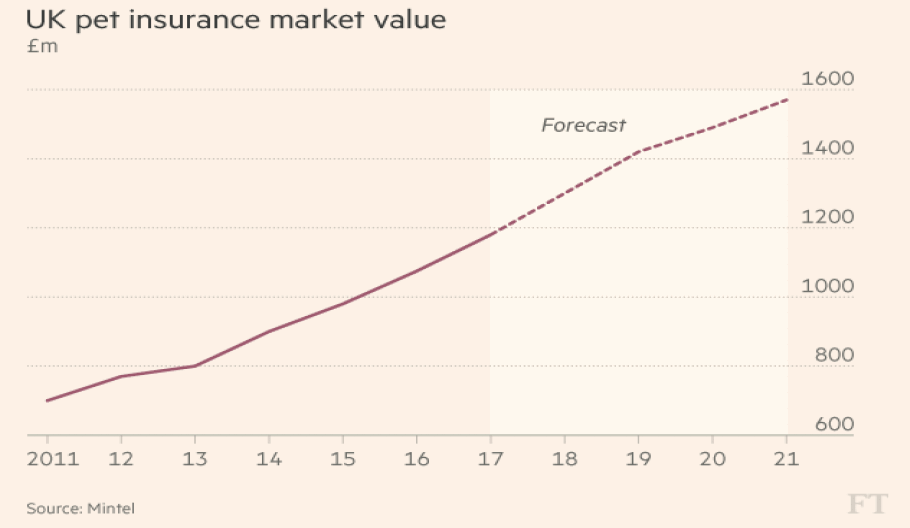
Figure 13 UK UK pet insurance market value (source: FT, 2017)
3.3 Impacts through the equine sector
Mayes (2015) reported that of the UK's 19,000 practicing veterinarians that around 10% are equine vets with about 300 equine practices, estimated to be turning over £300m per annum. These service the 1 million horses and ponies in the UK in an industry that has an economic impact of over £7bn and employs about 250,000 people (half the employment is in horse racing). Mayes (2015) estimates that 15% of equine veterinary services are specifically associated with horse racing, but the market is diverse and thriving through increased participation in dressage, show jumping and eventing.
TBA (2014) estimated that the British Thoroughbred Breeding Industry directly contributed £65m GVA to the UK economy (and a further £216m indirect and induced GVA impact) and was directly responsible for 3,546 jobs (and a further 6,454 indirect and induced jobs). They estimated that 13% of the £172m direct, non-staff expenditure incurred by the industry was on veterinary and farrier services (£22.6m), with 7% on insurance. Moreover, Deloite (2013) estimated that the UK horse racing industry spent some £90m on veterinary and farrier fees.
According to the British Equestrian Trade Association's (BETA) National Equestrian Survey 2015 (BETA, 2015), the UK equestrian market was worth £4.4bn in 2016 (adjusted for price inflation). In addition, BETA estimated that an additional value of £4.2bn from racing and £700m from other equestrian events are annually generated that produces a total annual value of £9,200m in 2016 (figures from Micoud et al., 2015 adjusted for price inflation). Assuming Scotland has 13%[10] of the UK horse population[11], it is estimated that the total value of the horse industry in Scotland is £1.2bn that consists: £583m market value, £554m generated from racing, and £90m generated from other events.
Figure 14. (a) Attendances of racecourses (to nearest ‘000) and (b) proportion of trainers by region: 2012
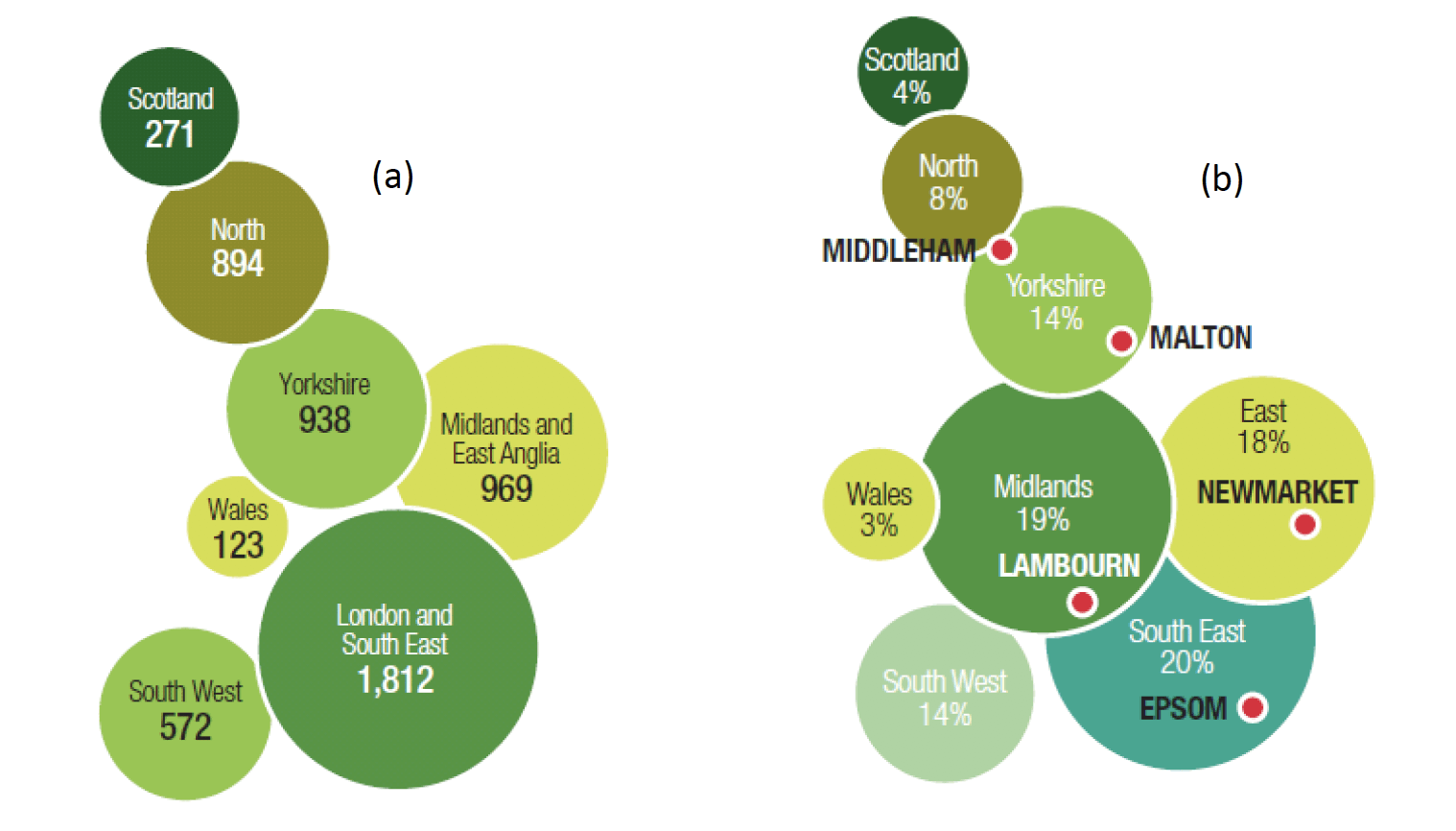
"British Racing continues to play a leading role in the advancement of equine veterinary research and techniques which brings benefits for the wider horse population in Britain, not just racehorses. A key role is played by the Levy Board Veterinary Advisory Committee, which advises on matters related to the advancement of veterinary science and education by recommending investment in priority areas, identified in consultation with the racing and breeding industries. The Levy Board awards funding grants for equine veterinary research projects based on these recommendations. In the last decade the Levy Board has invested over £20m in veterinary activities, including research and education." Deloite 2013
3.4 Veterinary Pharmaceuticals
The UK is a net exporter (£2.8bn positive trade balance of) of pharmaceutical products (both for human and veterinary usage) with the rest of the world (EFPIA, 2017). The value of the UK authorised veterinary medicine market is estimated at £700m (NOAH, 2018). Many of these medicines are prescribed and sold through veterinary practices. Assuming 42% percent of the pharmaceutical sales are related to farm animals (NOAH, 2018), and adjusting this figure for the Scotland's livestock (circa 20% of the UK total), the value of the pharmaceutical sales in Scotland for farm animals is estimated at £59m per year. Assuming Scotland has 8% of the UK population then it is estimated that the pet medicine sector is worth around £33m per year in Scotland.
Figure 15 UK market by product type for the 12 months to end of Quarter 1, 2017

Source: NOAH, 2018.
3.5 Impacts through public health, hygiene and surveillance
3.5.1 One Health
LaFayette and Buser (2017) highlighted that with a wider variety of illnesses common to animals and humans, veterinarians are providing important insights into the symptoms, and treatments, of a wide variety of conditions – a One Health approach. They suggest that "estimates of the share of emerging and re-emerging infectious diseases that adhere to the zoonosis pattern are as high as 70 percent of all diseases." This includes diseases such as Avian Influenza, rabies, Lyme disease, porcine flue, etc.
Figure 16 The One Health umbrella (Cassidy, 2018).
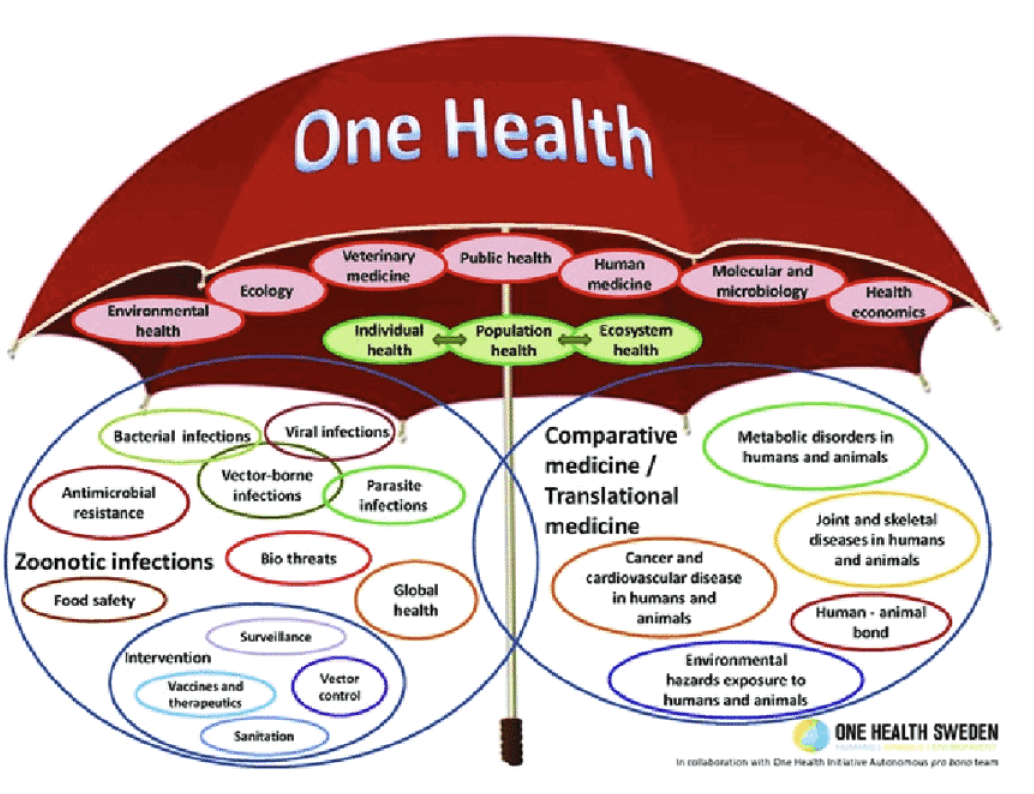
As veterinarians routinely observe and treat these diseases in a wide variety of animal species they have often adopted diagnostic methods and treatments that may be applicable to human disease interventions, thereby improving the effectiveness and cost of human treatments. There is growing recognition of the social and economic impacts that this One Health approach (Queenan et al., 2017) to human medicine can play globally, thereby extending the benefits to society of the veterinary profession.
Table 9 Industry official controls hourly rates 2017/18 (Food Standards Scotland, 2017)
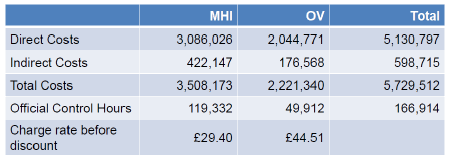
3.5.2 Abattoir and meat inspection
The veterinary profession plays a pivotal role in the Scottish meat sector, ensuring the quality of the product going to market. The total cost of meat hygiene inspections (MHI) and official veterinarians (OV) and was reported by the Food Standards Scotland at £5.9m in 2016 (Food Standards Scotland, 2016a).
3.5.3 Food-safety
The total budget allocated to food safety by the Food Standards Scotland in 2016/17 was reported at £15.3m (Food Standards Scotland, 2016b). Assuming 3%[12] of the spending in food safety activities was related to the veterinary profession, the value spent on directly on veterinary expertise was £0.4m. Figure 17 shows the incidence of the three most common food-borne diseases in the European Union (EFSA, 2017).
Figure 17. Most common food borne diseases in the EU, 2016.
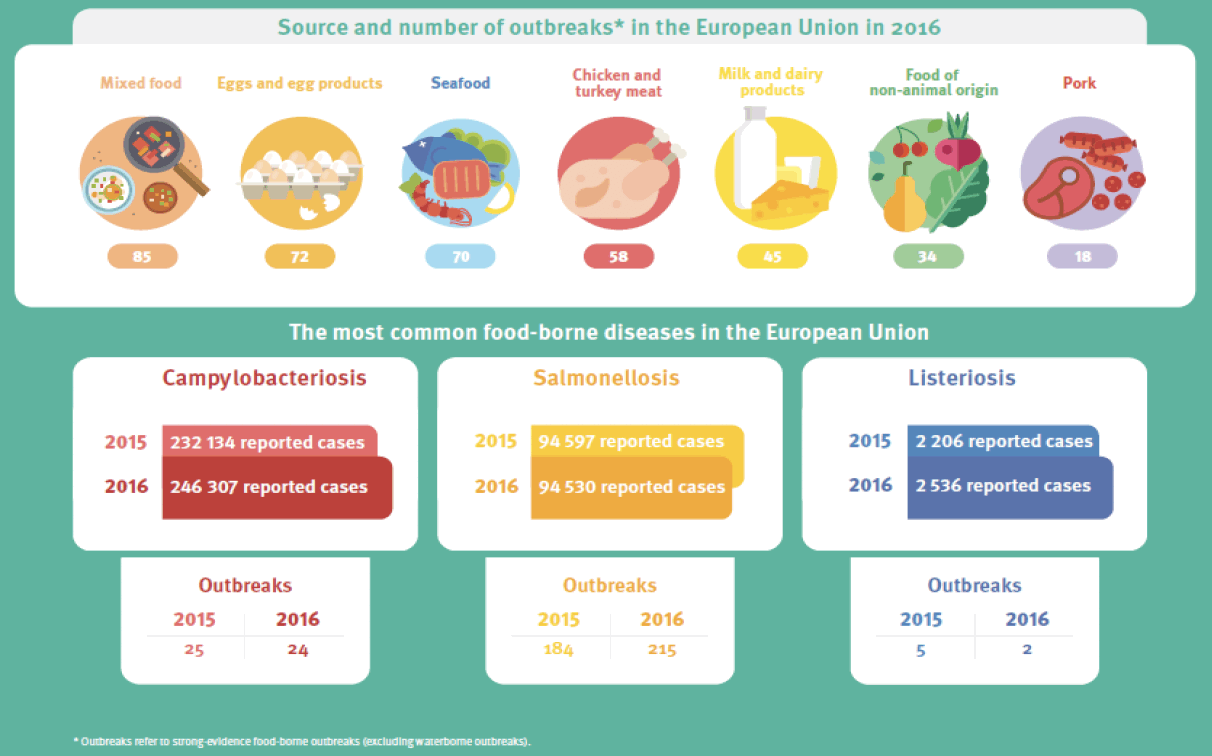
In addition to food-borne diseases as food-safety hazards, anti-microbial resistance (AMR) is considered as an emerging important grand global challenge. AMR is the quintessential 'One Health' challenge with the problem of careless use of antimicrobial (AM). In livestock, AMs are used for preventative and therapeutic purposes, but some evidence suggests that they are largely used in response to poor health/biosecurity. AMR is a multifaceted problem covering livestock systems, environment, plants, ecosystems and humans. Veterinary profession already plays a very crucial role in tackling this global challenge. However, as concerns over AMR become greater there may be an increased responsibility on veterinaries in sales of and applications of AMs. A recent rapid evidence assessment (Hockenhull et al., 2017) found that "Just over half (53 per cent) of 71 English and Welsh dairy farmers responding to a survey reported knowledge of the Responsible Use of Medicines in Agriculture Alliance's guidelines for use of AMs in cattle production in the UK, and 30 per cent were not aware of concerns over the use of third- and fourth-generation cephalosporins.Furthermore, 20 per cent of these farmers admitted that they do not always complete a full course of AMs as prescribed". Jones, et al. (2015) found that veterinarians were cited as farmers' most trusted information source in the UK.
3.5.4 Surveillance and diagnosis activities
The Scottish Government spends approximately £4 million per year on its Veterinary Services programme, delivered by SRUC (Scottish Government, 2011). This specifically supports livestock disease surveillance and animal health planning and welfare activities (including supporting SRUC's eight Disease Surveillance Centres (DSCs) where diagnostic services are conducted on submitted samples to provide information on the current health and disease status of Scottish farmed livestock - a statuary requirement for the Scottish Government). Clients also pay privately for some SAC consulting diagnostic services (circa £1.3 million revenue, including through health schemes Kenyon (2015)). In 2016/17 the Scottish Government funded activities included diagnostic tests on 5,475 farmed animal carcases and over 93,000 submissions of blood, faeces, swabs and other materials from veterinary surgeons in practice (this includes diagnostic work undertaken for of SAC Consulting through contract by the Moredun Research Institute). Information on disease and disease trends is captured for Scottish stakeholders and is also added to data from APHA laboratories and approved contractors in England and Wales to provide the picture for Great Britain. In 2016/17 this work included direct veterinary research (lab work) and support an extensive array of topics, such as: porcine epidemic diarrhoea virus; joint-ill; cattle abortion due to Bacillus licheniformis; liver fluke; bird flu; a new Salmonella strain causing abortions in sheep; Haemonchus contortus worm in sheep); antimicrobial resistance in livestock; Continual Professional Development for vets; development of the Scottish Animal Health Planning System; bee health improvement; wild bird disease surveillance SAC Consulting (2017). Kenyon (2015) reported that this surveillance and diagnostic work was undertaken by 144 staff, comprising 25 vets, 4 consultants, 57 scientists, 28 support staff and 30 admin staff.
In addition to the Scottish Government sponsored diagnostic services, the Moredun Research Institute run a commercial Virus Surveillance Unit[13] and Pathology Unit[14] to help improve understanding of animal disease and pathogens, and developing diagnostic tools and control mechanisms. This scientific work (overseen by veterinarians) is backed up with an extensive outreach programme, particularly to farmers and vets[15].
Contact
Email: Ian.Murdoch@gov.scot
There is a problem
Thanks for your feedback